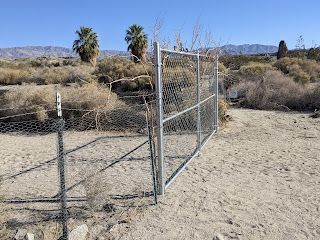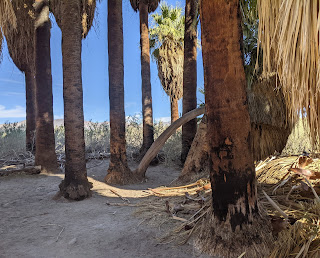Ten miles east of Palm Springs in the bluffs and mesas of Indio Hills lay the 20,000-acre Coachella Valley Nature Preserve. The natural area was cooperatively managed by the federal Bureau of Land Management, the US Fish and Wildlife Service, the privately-funded The Nature Conservancy, and the state of California's Department of Fish and Games.
Anyone living in the US is aware of the notorious San Andreas Fault and how California might one day be facing the 'big one' aka the earthquake. We learned that the fault ran roughly east and west through the northern part of Coachella Valley.
We overheard a volunteer ranger say the preserve was also home to several palm oases formed because San Andreas Fault lines allow water flowing underground to rise to the surface. He mentioned the Thousand Palms Oasis comprised California fan desert palm trees that had existed since the time of dinosaurs!
In the center of the oasis was the Paul Wilhelm Grove, also the location of the preserve’s rustic visitor’s center.
I don't ever remember seeing palm trees pruned on trails before as they were on this mile-long boardwalk. The trail wound past pools containing endangered desert pupfish.
Because the Coachella Valley climate is similar to ancient Mesopotamia, dates can be grown.
For thousands of years, particles of sand from the San Bernardino Mountains and Indio Hills washed into the Coachella Valley, forming a system of dunes.
The marsh areas provided significant habitat for many plants and animals including bobcats and cougars who prefer moving in the thick vegetation or 'feline highways' to hunt as they move.
The preserve was home to several species of increasingly rare wildlife including the Coachella Valley fringe-toed lizard that depends on this unusual blowsand desert for survival. The lizard "swims" through the sand to escape predators or summer heat on the desert surface.
We were advised to keep our hands and feet where we could see them, i.e. stay on the trails, in this sensitive habitat area because of rattlesnakes in the marsh's deep brush. Duly noted!
Twenty-five miles of hiking trails wound through the oases, covering a few different ecosystems ranging from sand dunes, mountain canyons, or dried-up riverbeds.
Unfortunately, the rest of the McCallum Pond Trail was closed because it was being worked on. Oh well, we figured that was a great reason to return for Steven's birthday next year as we always like to leave something to come back to.
I wondered what scary animals lurked in this marshy area!
We then followed the Smoke Tree Ranch Trail back to the Thousand Palm oasis.
Even though we've spent a good chunk of time in the Southwest, we'd never heard of cattle spinach before whose range extends to Utah and Mexico. Apparently, however, the high-value forage for cattle and native browsers is common in both the Mojave and Colorado deserts.
The preserve and, in particular, the oasis was a hidden gem in the middle of the desert!
We spent most of the afternoon lounging by the resort's pool that backed up to one of Palm Springs' 100 golf courses. What a life we have we keep reminding ourselves!
Next post: Hiking at Indian Canyon outside of Palm Springs.
Posted on February 26th, 2022, from Phoenix where we're spending the last few days here hiking each morning and soaking up more sun each afternoon before returning to the much colder Denver.





























No comments:
Post a Comment